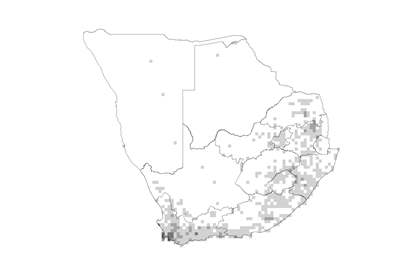 Species distribution and density. Darker squares represent higher density of members of this family. |
Introduction
Rose family
This family is famous for its cultivated flowering and fruiting species and cultivars. It has the highest level of endemism in Asia (20 genera) and North America (17 genera), with only 5 genera endemic to Africa. In southern Africa most members of this family are introduced or naturalised, except for Cliffortia, Leucosidea and a handful of species in other genera. A number of species are aggressive weeds.
Distribution
Found mainly in the northern temperate regions of the world. In southern Africa Cliffortia occurs predominantly in the Western Cape and the other genera in the eastern part of South Africa.
Number of genera in the world
85-122
Number of species in the world
2 000-3 350
Number of genera in the Flora of southern Africa region
17
Number of species in the Flora of southern Africa region
220
Well-known southern African genera
Cliffortia, Geum, Leucosidea, Prunus, Rubus
Growth forms
Trees, shrubs or climbers; rarely herbaceous.
Habitats
In valleys, on mountain slopes, along streams and on disturbed sites.
Flagship species
Leucosidea sericea (ouhout [A]; umtshitshi [Z]) is quite widespread in the eastern parts of South Africa. Trees have gnarled and bent stems and trunks with bark peeling off in strips. Leaves are deeply serrated, dark green above with a prominent furrowed midvein, silky-white below. Flowers are yellow-green and borne in a dense spike. Trees are easy to cultivate and fast-growing; a good choice for small, frost-prone gardens.
Significance of the family
The family is best known for its edible fleshy fruits (e.g. apples, peaches, apricots, cherries, strawberries, almonds, raspberries, brambles). It is also known for its attractive ornamentals in gardens, parks and as street trees (e.g. *Rosa, *Prunus, and *Pyracantha). Other uses include pectin (from apples), and rose oil (from *Rosa species). The bark of Prunus africana (African almond) is used medicinally. This species occurs throughout tropical Africa and is harvested to such an extent by traditional healers that it is protected in many countries. Several introduced species are noxious weeds (e.g. bramble) in various parts of the world.
Diagnostic characters
Stems often with prickles , stipules on twig or on base of petiole �. Leaves alternate. Perianth and stamens united at base into a cup (hypanthium) �; hypanthium usually well developed with epicalyx, sepals, petals and stamens inserted on its rim, inside usually lined with nectariferous tissue; sepals and petals free ; ovary superior to inferior; stamens few to numerous, filaments free �.
Did you know?
Rose oil is one of the most expensive essential oils and Bulgaria is the biggest producer in the world.